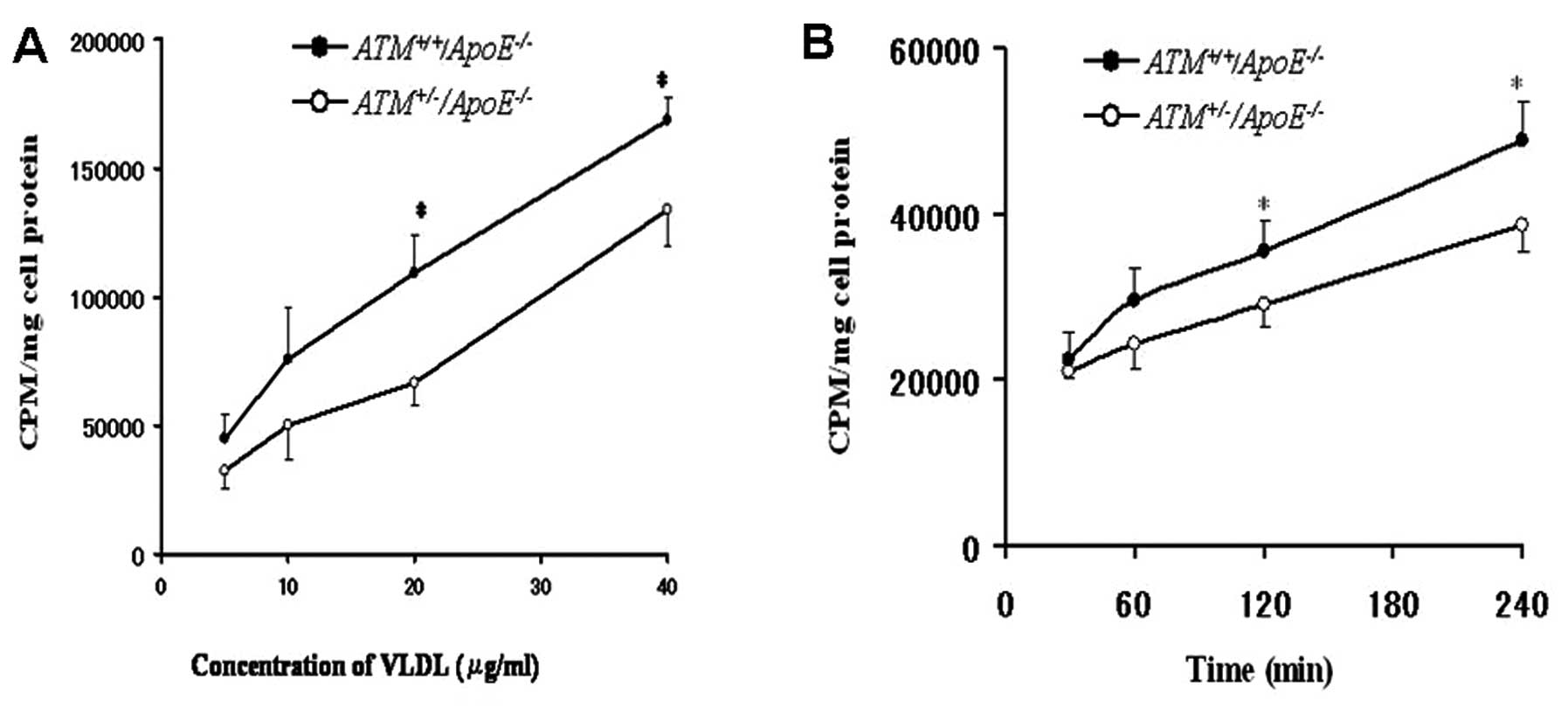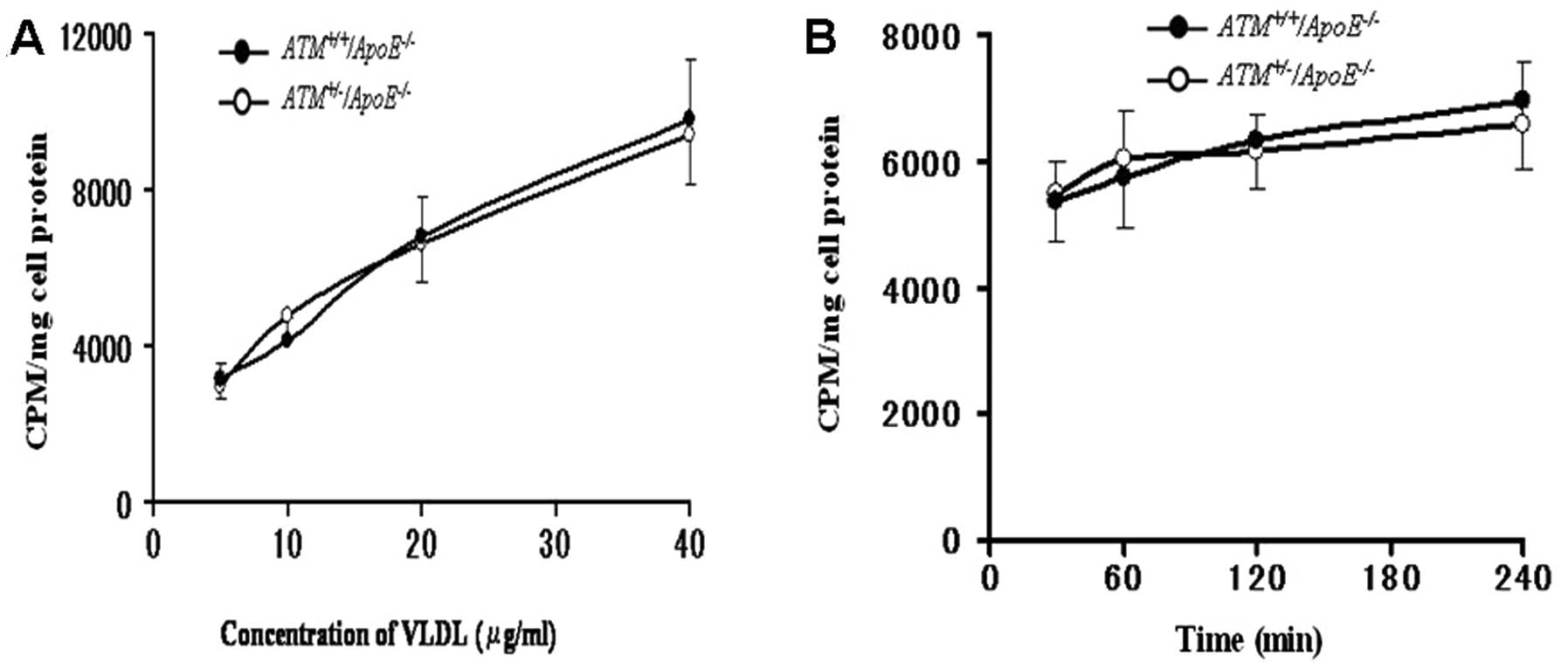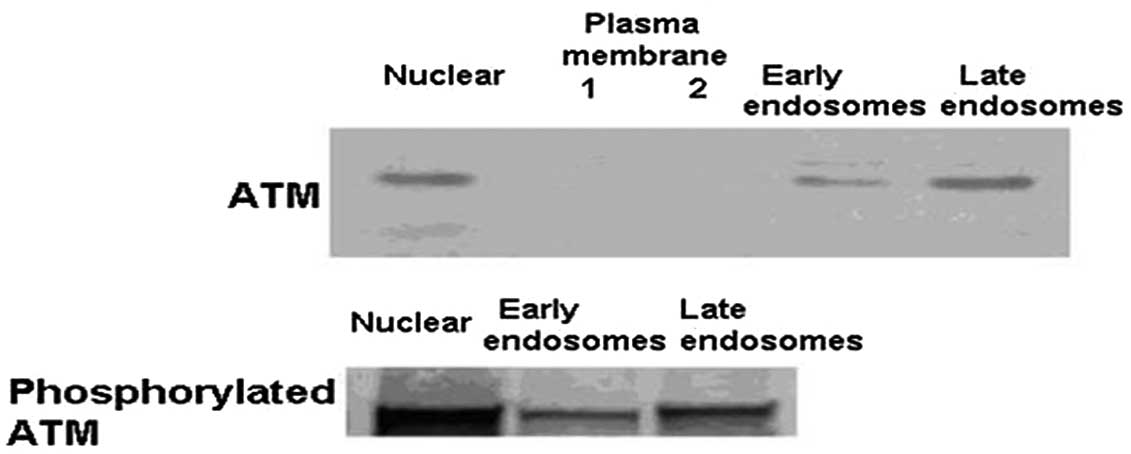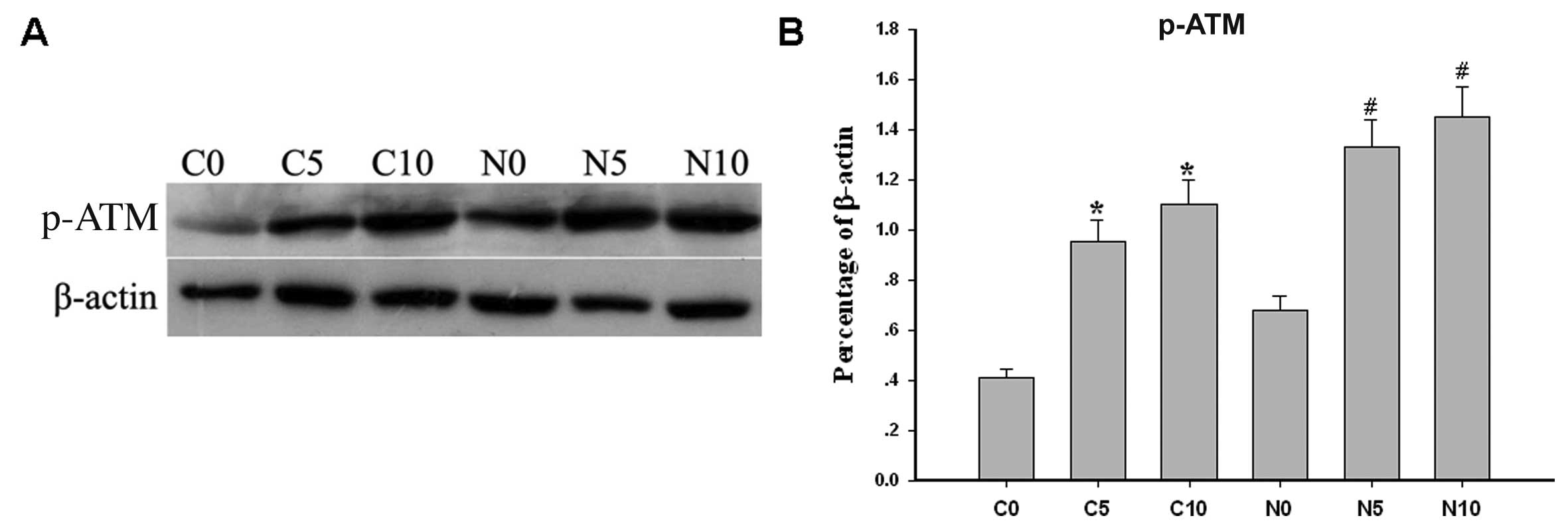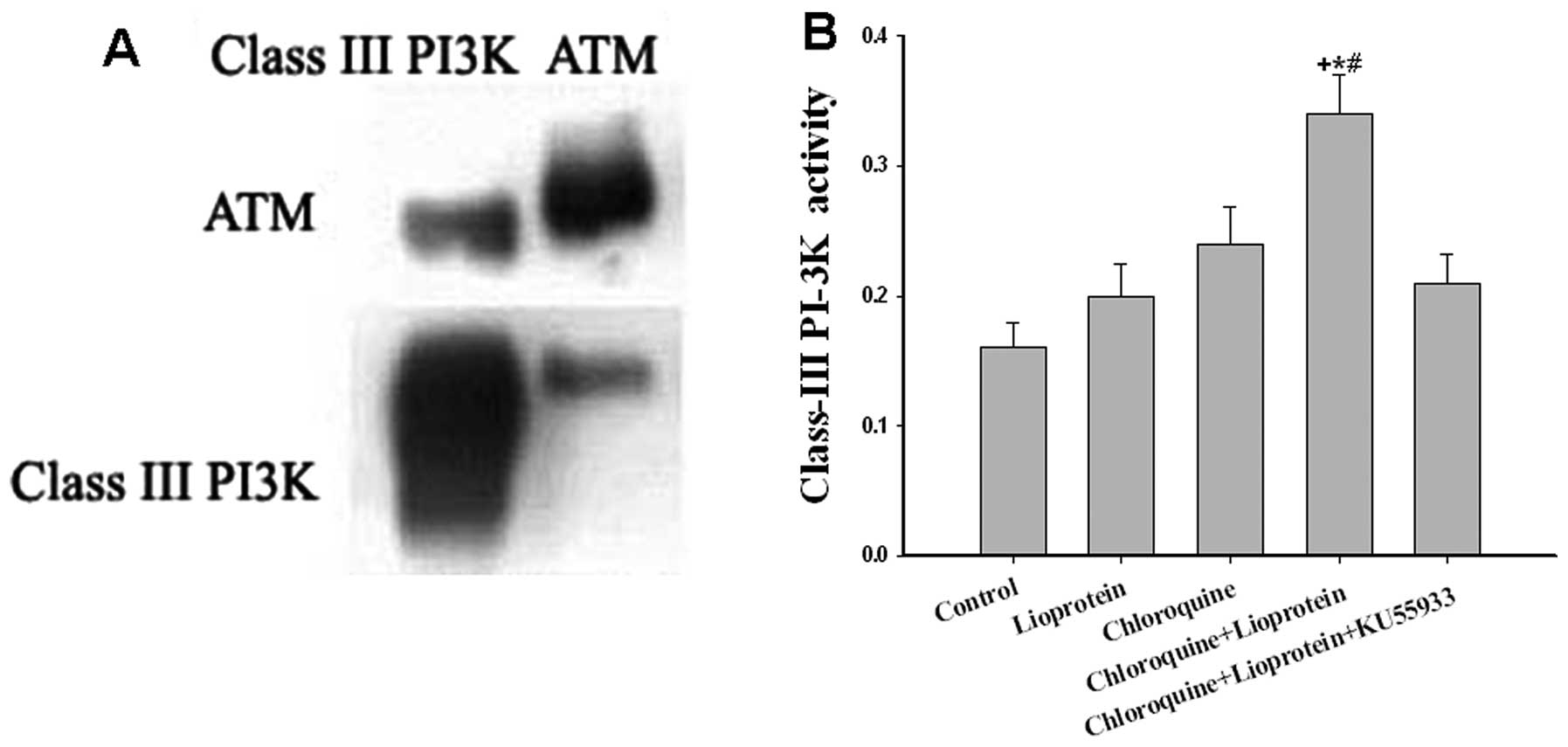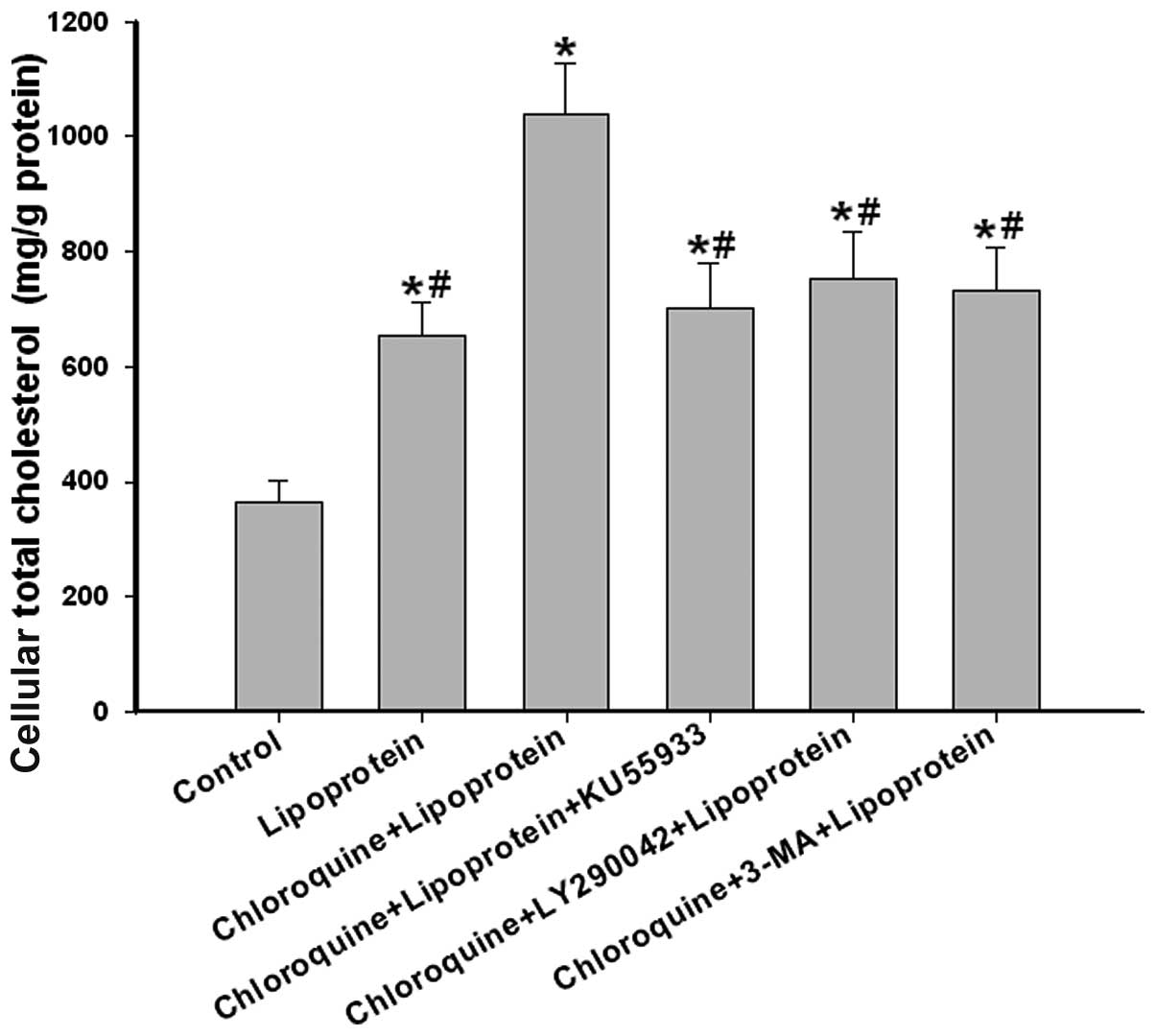Potential role of ATM in hepatocyte endocytosis of ApoE-deficient, ApoB48-containing lipoprotein in ApoE-deficient mice
- Authors:
- Published online on: November 26, 2013 https://doi.org/10.3892/ijmm.2013.1566
- Pages: 462-468
Abstract
Introduction
Patients with ataxia telangiectasia (A-T), carrying mutations at both ataxia telangiectasia mutated (ATM) alleles (ATM−/−), present with progressive cerebellar ataxia, susceptibility to cancer, immunodeficiency, insulin resistance and hyperglycemia (1,2). In addition, patients with A-T reportedly have increased plasma cholesterol and triglyceride levels (3), which are the two major risk factors for atherosclerosis. It is currently known that humans with the heterozygous ATM mutation (ATM+/−), which account for 0.5–2% of the total population, also have an increase risk of developing atherosclerosis-related cardiovascular diseases (4). Previous studies have suggested that defective ATM function promotes atherosclerosis through multiple systemic pro-atherosclerotic features, such as metabolic syndrome, oxidative stress, DNA damage and mitochondrial dysfunction (5,6). We have prevoiusly demonstrated that ATM assists the clearance of plasma apolipoprotein (Apo)E-deficient, ApoB48-containing (E−/B48) lipoproteins in ApoE-deficient mice (ApoE−/− mice) (7). However, to date, there is no exact explanation available as to the mechanisms through which ATM is involved in the endocytosis or removal of E−/B48 lipoproteins in ApoE−/− mice.
It is now known that a fraction of the ATM protein is also present in the cytoplasm and is associated with vesicular structures, such as peroxisomes, lysosomes and endosomes (8–10), which indicates that ATM may be involved in the trafficking of proteins and vesicles. Certain studies have reported that in the absence of ATM, intracellular vesicle and/or protein transport may be impaired, leading to abnormalities in endosomal function (11). Therefore, we hypothesized that ATM mutations in ApoE−/− mice may lead to an overaccumulation of plasma ApoB-48-containing lipoproteins, thus promoting the development of atherosclerosis, which may be associated with the loss of or the impaired function of cytosolic ATM protein. This may affect the process of endocytosis of lipoproteins or it may influence lipid metabolism enzymes involved in the endocytic scavenging process, and transport of proteins to the peroxisomes and/or lysosomes.
Phosphatidylinositol-3-kinases (PI3Ks), are known to play a key role in a wide range of cellular functions, including cell growth, proliferation, differentiation, motility and survival (12). It is also evident that PI3Ks play an important role in endocytosis and vesicle transport, including a role in the recruitment of regulatory proteins to the plasma membrane, endocytic uptake and recycling of receptors (13). Class III PI3Ks are responsible for the production of phosphatidylinositol-3-phosphate [PtdIns(3)P] (14), which is enriched in the membranes of early endosomes and the internal vesicles of multivesicular bodies (15,16). PtdIns(3)P recruits proteins containing FYVE, PX or PH motifs, and is involved in the control of vesicular transport and intracellular protein sorting (17,18). Certain studies have reported that PI3Ks are involved in the metabolism of different lipoproteins. For example, Shetty et al (19) demonstrated that PI3K plays an important role in class B type I scavenger receptor subcellular localization and selective lipid uptake in hepatocytes. Kzhyshkowska et al (20) reported that PI3K activity is required for the transfer of stabilin-1 and its ligand, acetylated low-density lipoprotein, from early endosomes to late endosomes. As ATM has been shown to possess a carboxyl-terminal domain homologous to PI3Ks and that the ATM protein regulates PI3K protein activity (21,22), we hypothesized that PI3K may involved in the promotion of E−/B48 lipoprotein endocytosis by cytoplasmic ATM in the hepatocytes of ApoE−/− mice.
In this study, we demonstrate that heterozygous ATM mutation reduces the hepatocyte uptake of E−/B48 lipoproteins in ApoE−/− mice and that the ATM protein is distributed in early and late endosomes. In addition, we reveal that the activated ATM protein interacts with class III PI3K and affects its activity and that a class III PI3K inhibitor attenuates the intracellular total cholesterol accumulation induced by ATM activation. The data presented in this study, provide insight into the mechanisms behind the involvement of ATM in the process of endocytosis of E−/B48 lipoproteins.
Materials and methods
Animals
ATM+/− mice were kindly provided by Dr Anthony Wynshaw-Boris (University of California, San Diego, CA, USA). ApoB48/48/ApoE−/− and 129vEv wild-type mice were obtained from the Jackson Laboratory (Bar Harbor, ME, USA). ApoB48/48/ApoE−/− mice were obtained by crossbreeding ApoE−/− mice with ApoB48/48 mice. ATM+/−/ApoE−/− mice were obtained by crossbreeding ATM+/− and ApoE−/− mice. In the present study, ATM+/−/ApoE−/−mice were used at 14 weeks of age. The mice appeared as healthy as their ATM+/+/ApoE−/− littermates. All procedures for handling the animals were approved by the Institutional Animal Care and Use Committees of Meharry Medical College (Nashville, TN, USA) and were performed in accordance with the guidelines of the American Association for the Accreditation of Laboratory Animal Care and the National Institutes of Health and Animal Care Guidelines of the Animal Experimental Committee of the College of Medicine, Wuhan University, Wuhan, China.
Hepatocyte isolation and culture
Hepatocytes were isolated from ApoE−/− mice. After the mice were anesthetized and the livers exposed, the livers were first perfused with calcium-free buffer for 1.5 min and then perfused with 0.25% (w/w) collagenase type I (nitrogen) at 37°C in Williams E nutrient medium for 4 min. Subsequently, the hepatocytes were isolated by gently mincing the livers in Williams E nutrient medium containing 0.25% collagenase type I, filtered through a nylon gauze, and centrifuged twice for 5 min at 50 × g at 4°C. The cell pellets consisted of pure hepatocytes, as confirmed under a light microscope, and the viability of the cells was 90% as determined by trypan blue exclusion assay.
Preparation of E−/B48 lipoproteins
E−/B48 lipoproteins were prepared from the plasma of ApoB48/48/ApoE−/− mice as previously described in the study by Wu et al (7). Briefly, mouse plasma was overlaid with KBr gradient solution (d<1.006) and centrifuged at 120,000 rpm for 2 h with a Sorvall Discovery M150 ultracentrifuge (Thermo Scientific, Waltham, MA, USA). The E−/B48 lipoproteins were collected, dialyzed in phosphate-buffered saline (PBS) (pH 7.4) containing 10 mM EDTA for 48 h at 4°C, and filtered through a 0.45 μm filter. One milliliter of E−/ B48 lipoproteins at a concentration of 1 mg/ml was mixed with 0.2 ml of 1 M glycine buffer in 0.25 M NaOH (pH 10) and then mixed with a solution containing 7 μl of 100 mM iodine monochloride, 7 μl of 100 μCi/μl 125I, and 25 μl of 1 M glycine buffer in 0.25 M NaOH (pH 10). Subsequently, the reaction mixture was incubated at room temperature for 10 min and then applied to a 10 DG chromatography column (Bio-Rad Laboratories, Hercules, CA, USA) to remove free iodine. The 125I-labeled E−/B48 lipoproteins were eluted with PBS (pH 7.4) and dialyzed extensively against PBS (pH 7.4).
Binding and uptake assays
For the uptake experiments, the cells were washed twice with 2 ml of serum-free medium, containing 0.2% BSA. The cells were then incubated with 1 ml of the same medium, containing various concentrations of labeled E−/B48 lipoproteins [very-low-density lipoprotein (VLDL)] for 2 h or containing 20 μg/ml labeled E−/B48 lipoproteins for 30, 60, 120 and 240 min. For the determination of surface bound proteins, the cells were pre-chilled on ice for 30 min before washing and incubating in medium containing E−/B48 lipoproteins; the cells were then incubated with 1 ml of the same medium, containing various concentrations of labeled E−/B48 lipoproteins for 2 h or containing 20 μg/ml labeled E−/B48 lipoproteins for 30, 60, 120 and 240 min. Following incubation with E−/B48 lipoproteins, the medium was removed and the cells were washed twice with 2 ml of ice-cold PBS containing 0.2% BSA followed by 2 more washes with 2 ml of ice-cold PBS. The cells were lysed by the addition of 1 ml of 0.5 M NaOH and lysate was collected for the measurement of protein (10 μl of aliquot) and radioactivity taken up by the cells.
Endosomal fraction isolation
Mouse liver endosomal fractions were isolated as prevously described by Chen et al (23). Mouse livers were homogenized in 20% (w/v) homogenization buffer containing 0.25 M sucrose, 3 mM imidazole (pH 7.4), 1.7 nM antipain, 2 nM leupeptin and 1 mM phenylmethylsulfonyl fluoride. The homogenate was centrifuged at 460 × g for 10 min, the supernatant was saved and the pellet was rehomogenized and centrifuged as described above. The pooled supernatant was centrifuged at 24,000 × g for 10 min, and the resulting supernatant (S2) was then centrifuged at 100,000 × g for 90 min. The resulting microsomal pellet (P3) was suspended in homogenization buffer (1.0 g starting liver/2 ml homogenization buffer) using 10 strokes at 1,000 rpm. The resuspended P3 was then diluted with an equal volume of 2.0 M sucrose in 3 mM imidazole buffer. Three milliliters aliquots of the resulting 1.15 M sucrose fraction were successively overlaid with 1.0, 0.86, 0.6 and 0.25 M sucrose solutions, all buffered with 3 mM imidazole. Following centrifugation at 100,000 × g for 3.5 h, 3 distinct fractions of average density 1.06, 1.09 and 1.12 g/ml were obtained. The 1.06 and 1.09 fractions were pooled to yield the late endosomal fraction, and the 1.12 g/ml fraction contained early endosomes.
Western blot analysis
Endosomal fractions were isolated and prepared as described above. Endosomal proteins were extracted by a dual precipitation procedure. First, endosomal fractions were suspended in 20% trichloroacetic acid (TCA) with 20 mM DTT (1 g of starting liver/2 ml 20% TCA). Second, the suspension was allowed to precipitate on ice for 2 h and centrifuged at 1000 × g for 10 min, and the pellet was then suspended in acetone with 20 mM DTT (1 g of starting liver/2 ml acetone). Proteins in the suspension were precipitated at −20°C for 4 h and centrifuged at 1,000 × g for 5 min. Residual acetone was removed by lyophilization. The protein pellet was solubilized in lysis buffer, sonicated at 100 W for 30 sec, and centrifuged at 25,000 × g for 1 h. Plasma membrane proteins were extracted using the Plasma Membrane Protein Extraction kit (Abcam, Cambridge, MA, USA). Nuclear and cytoplasmic proteins from the cells were extracted using the Nuclear-Cytosol Extraction kit (BioVision, Inc., Milpitas, USA). Protein expression was determined by western blot analysis. Briefly, equal amounts of protein were separated by 7.0 or 10% SDS-polyacrylamide gel electrophoresis (SDS-PAGE) and elcetrophoretically transferred onto nitrocellulose membranes. After being blocked with TBST containing 5% bovine serum albumin, the membranes were incubated with primary antibodies against ATM (Santa Cruz Biotechnology, Inc., Santa Cruz, CA, USA) and phosphorylated ATM (p-ATM) protein (Cell Signaling Technology, Danvers, MA, USA) at 4°C overnight, followed by incubation with horseradish peroxidase-conjugated secondary antibody for 1 h at room temperature. The immunostaining was visualized by enhanced chemiluminescence, and the results were normalized to β-actin expression.
Co-immunoprecipitation
The hepatocytes were pre-treated with chloroquine (an ATM activator) for 1 h and then treated with 40 μg/ml lipoproteins for 8 h. Cytoplasmic proteins (500 μg) from the cells extracted using the Nuclear-Cytosol Extraction kit were used to perform immunoprecipitation assays according to the manufacturer’s instructions (Pierce, Rockford, IL, USA). Briefly, the cytoplasmic lysates were incubated with ATM or class III PI3K antibody (Santa Cruz Biotechnology, Inc.) for 2 h at room temperature followed by the addition of protein A/G-Sepharose beads and further overnight incubation at 4°C with gentle rocking. The immunoprecipitates were washed 3 times with lysis buffer. The samples were then subjected to SDS-PAGE and immunoblotting.
Class III PI3K activity assay
Cytoplasmic proteins from cells were extracted using the Nuclear-Cytosol Extraction kit (BioVision). The proteins were immunoprecipitated with anti-class III PI3K antibody for 2 h at room temperature, and subsequently incubated with A Sepharose beads overnight at 4°C. The precipitates were then washed with lysis buffer. The immunoprecipitated proteins were incubated with PIP substrates in vitro, and the PI(3)P products were measured with the use of class III PI3K ELISA kit (Echelon Biosciences, Salt Lake City, UT, USA) according to the manufacturer’s instructions.
Measurement of cellular cholesterol
Hepatocytes grown in 75-mm culture flasks were pre-treated with 5 μM chloroquine, 10 μmol/l KU55933 (an ATM-specific inhibitor), 10 μM LY290042 (a class III PI3K inhibitor) or 5 mM 3-MA (a class III PI3K inhibitor) for 2 h and then incubated with 40 μg/ml E−/B48 lipoproteins for 22 h followed by a 12-h equilibrium in lipoprotein-free medium. Quantitative measurement of intracellular total cholesterol (TC) in vitro was analyzed using the method described in the study by Gamble et al (24). In brief, the hepatocytes were collected and lipids were extracted by the addition of chloroform:methanol (2:1). The lipid phase was collected, dried, and then dissolved in isopropanol containing 10% Triton X-100. The concentrations of TC were measured by enzymatic assays and normalized to total cellular protein levels.
Statistical analysis
The data are expressed as the means ± SEM. Comparisons among multiple groups were performed using one-way ANOVA or two-way ANOVA followed by the Student-Newman-Keuls or Dunnett’s test. Differences were considered significant at P<0.05.
Results
Uptake of E−/B48 lipoproteins
Both ATM+/−/ApoE−/− and ATM+/+/ApoE−/− hepatocytes absorbed E−/B48 lipoproteins in a concentration and time-dependent manner. However, the uptake of E−/B48 lipoproteins by the ATM+/+/ApoE−/− hepatocytes was greater than that of the ATM+/−/ApoE−/− hepatocytes. The uptake of E−/B48 lipoproteins by the ATM+/+/ApoE−/− hepatocytes was greater by 38–65% compared with the ATM+/−/ApoE−/− hepatocytes at the concentration range of 5–40 μg/ml; in particular, a significant difference was observed between the ATM+/−/ApoE−/− and ATM+/+/ ApoE−/− hepatocytes at the concentration range of 20–40 μg/ml and at the 120 and 240 min time points (P<0.05) (Fig. 1).
Binding of E−/B48 lipoproteins
Both ATM+/−/ApoE−/− and ATM+/+/ApoE−/− hepatocytes bound E−/B48 lipoproteins in a concentration-dependent manner. However, no significant difference was observed in the binding of E−/B48 lipoproteins to the ATM+/−/ApoE−/− and ATM+/+/ApoE−/− hepatocytes at the concentration range of 5–40 μg/ml (Fig. 2A). The binding of E−/B48 lipoproteins to the ATM+/−/ApoE−/− and ATM+/+/ApoE−/− hepatocytes was not enhanced and no significant difference was observed as time progressed (Fig. 2B).
Distribution of ATM protein in endosomes and ATM activation by chloroquine in the nucleus and cytoplasm
ATM protein and p-ATM protein were expressed in the nucleus, early endosomes and late endosomes, but not in the plasma membrane in the hepatocytes of ApoE−/− mice (Fig. 3). The hepatocytes of ApoE−/− mice were incubated with various concentrations of chloroquine (0, 5 and 10 μmol/l) for 8 h at 37°C. p-ATM levels in the nucleus and cytoplasm increased following treatment with chloroquine in a dose-dependent manner (P<0.05) (Fig. 4).
ATM protein interaction with class III PI3K protein and its effect on class III PI3K activity
As ATM has been shown to possess a carboxyl-terminal domain homologous to PI3Ks and that ATM protein regulate PI3K activitys, we wished to determine whether ATM interacts with class III PI3Ks and whether ATM activation affects the activity of class III PI3Ks. The results from co-immunoprecipitation analysis indicated that cytoplasmic ATM protein interacted with cytoplasmic class III PI3K protein (Fig. 5A). In addition, when the hepatocytes were incubated with E−/B48 lipoproteins alone, class III PI3K protein activity increased; however, no significant difference was observed between the control group (untreated group) and the group treated with E−/B48 lipoproteins (P>0.05). When the hepatocytes incubated with E−/B48 lipoproteins and chloroquine, class III PI3K activity markedly increased (P<0.01); however, this effect was attenuated by the ATM inhibitor, KU55933 (P<0.05) (Fig. 5B).
Class III PI3K inhibitor attenuates intracellular total cholesterol accumulation induced by ATM activation
When the hepatocytes were incubated with E−/B48 lipoproteins alone, the intracellular total cholesterol of the hepatocytes increased, compared with the control (untreated) group (653.8±58.2 vs. 362.5 ± 38.2 mg/g protein). When the hepatocytes were incubated with E−/B48 lipoproteins and chloroquine, the intracellular total cholesterol of the hepatocytes markedly increased compared with the lipoprotein-treated group (1038.5±88.3 vs. 653.8±58.2 mg/g protein). However, treatment with the ATM inhibitor, KU55933, and the class III PI3K inhibitor, LY290042 and 3-MA, abolished the intracellular total cholesterol accumulation induced by chloroquine (702.8±78.6 vs. 1038.5±88.3 mg/g protein), (753.3±82.5 vs. 1038.5±88.3 mg/g protein) or (732.2±76.3 vs. 1038.5±88.3 mg/g protein), respectively (Fig. 6).
Discussion
The major findings of the present study are as follows: i) the uptake of E−/B48 lipoproteins by the ATM+/+/ApoE−/− hepatocytes was greater than that of the ATM+/−/ApoE−/− hepatocytes, although no significant difference was observed in the binding of E−/B48 lipoproteins between the ATM+/+/ApoE−/− and ATM+/−/ApoE−/− hepatocytes; ii) a fraction of the ATM protein was expressed in early endosomes and late endosomes, but not in the plasma membrane; iii) ATM protein interacted with class III PI3K protein and the activated ATM protein enhanced class III PI3K activity; iv) the class III PI3K inhibitor, LY290042, abolished the intracellular total cholesterol accumulation induced by ATM activation.
Under physiological conditions, ApoE activates receptor-mediated endocytosis by binding to cell surface low-density lipoprotein (LDL) receptor and LDL receptor-related protein (LRP) (25). The deletion of ApoE, lipoproteins containing ApoB100 (such as LDL) can still be achieved by the interaction between ApoB100 and LDL receptor, but lipoproteins containing ApoB48 can not enter cells through the LDL receptor and LRP (26). We previously reported that ATM heterozygous mutation in ApoE−/− mice resulted in an overaccumulation of plasma ApoB48-containing lipoproteins and severe hypercholesterolemia occurred only with a combination of a heterozygous ATM mutation and a null ApoE mutation, but not wih the heterozygous ATM mutation alone or with the combined heterozygous ATM and null LDL receptor mutations (7). The present experimental results revealed that despite the lack of ApoE, lipoproteins containing ApoB48 can still be absorbed. Compared with hepatocytes of ATM+/+/ApoE−/− mice, the uptake of E−/B48 lipoproteins by hepatocytes of ATM+/−/ApoE−/− mice decreased significantly; however, no signficant difference was observed in the binding of E−/B48 lipoproteins between hepatocytes from ATM+/+/ApoE−/− mice and those of ATM+/−/ApoE−/− mice. Based on these results, it can be concluded that there are other pathways mediating the endocytosis of lipoproteins containing ApoB48 without ApoE, and ATM facilitates the endocytosis of lipoproteins containing ApoB48. In addition, we found that a portion of the ATM protein was localized in early endosomes and late endosomes, but not in the plasma membrane. These results indicate that the ATM protein may participate in the endocytosis of E−/B48 lipoproteins.
Since we observed that the ATM protein was expressed in endosomes and it is known that class III PI3Ks are responsible for the production of PtdIns(3)P in the membranes of endosomes, and mediate vesicular transport, membrane trafficking and intracellular protein sorting (14,27,28), our study focused on the effects of ATM on the activity of class III PI3Ks. Certain studies have reported that small doses of chloroquine activate nucleic ATM proteins (29). In this study, we observed that chloroquine activated ATM in the nucleus and cytoplasm of hepatocytes in a dose-dependent manner. ATM has been shown to possess a carboxyl-terminal domain homologous to PI3Ks and ATM protein has been shown to interact with PI3K, regulating PI3K activity (21,22). Similar to this result, in our present study, we observed an interaction between cytoplasmic ATM and class III PI3Ks; activated ATM increased class III PI3K protein activity. Moreover, chloroquine, which activated ATM protein, promoted intracellular total cholesterol accumulation, while the class III PI3K inhibitor, LY290042 and 3-MA, inhibited this effect, suggesting that class III PI3K protein plays an important role in the ATM protein-mediated endocytosis of E−/B48 lipoproteins in the hepatocytes of ApoE−/− mice.
Previous studies have confirmed that there are ApoE-independent mechanisms which mediate the uptake of lipoproteins containing ApoB48. Magoori et al (30) reported that ApoE and LRP-5 double knockout mice developed more severe hypercholesterolemia than ApoE−/− mice and that this hypercholesterolemia resulted mainly from an increased level of ApoB-48-containing lipoproteins in the plasma, wheras LRP-5 single knockout mice showed no significant difference in plasma cholesterol levels. These results indicate that the LRP-5 mediates the ApoE-independent plasma lipoprotein metabolism pathway. Therefore, it is possible that E−/B48 lipoproteins interact with cell membrane receptors, such as LRP-5 through unknown mechanisms, and may activate cytosolic ATM; activated ATM in turn activates class III PI3K, regulating the endocytosis of E−/B48 lipoproteins. This may facilitate E−/B48 lipoprotein degradation and metabolism. Based on these results, we hypothesized that the ATM/class III PI3K pathway may be involved in the endocytosis of E−/B48 lipoproteins. In addition, it is evident that chloroquine exerts an inhibitory effect on blood lipids; however, the exact mechanisms involved are unclear. Our results suggest that the decrease in blood lipid levels by chloroquine may be associated with the activation of the ATM/class III PI3K pathway, thus promoting the uptake of lipoproteins by hepatocytes.
In conclusion, to the best of our knowledge, the results presented in this study demonstrate for the first time that a heterozygous mutation in ATM reduces the uptake of E−/B48 lipoproteins by hepatocytes of ApoE−/− mice. We also found that ATM was distributed in early endosomes and late endosomes. Our results demonstrated that the ATM protein interacted with class III PI3K protein and the activated ATM protein enhanced class III PI3K activity. In addition, the ATM activation promoted intracellular total cholesterol accumulation; however, this was abolished by the class III PI3K inhibitor, LY290042. These observations suggest that ATM is involved in the endocytosis of E−/B48 lipoproteins through the class III PI3K protein. Our findings provide further insight into the mechanisms through which the ATM activation by chloroquine exerts beneficial effects, reducing blood lipid levels.
Acknowledgements
This study was supported by a grant from the National Nature Science Foundation of China (30971428 to D.W.).
References
|
Frappart PO and McKinnon PJ: Ataxia-telangiectasia and related diseases. Neuromolecular Med. 8:495–511. 2006. View Article : Google Scholar : PubMed/NCBI | |
|
Lavin MF: ATM: the product of the gene mutated in ataxia-telangiectasia. Int J Biochem Cell Biol. 31:735–740. 1999. View Article : Google Scholar : PubMed/NCBI | |
|
Badalian LO and Kalinina LV: Lipid metabolism disorder in ataxia-telangiectasia. Zh Nevropatol Psikhiatr Im S S Korsakova. 76:665–669. 1976.(In Russian). | |
|
Su Y and Swift M: Mortality rates among carriers of ataxia-telangiectasia mutant alleles. Ann Intern Med. 133:770–778. 2000. View Article : Google Scholar : PubMed/NCBI | |
|
Schneider JG, Finck BN, Ren J, et al: ATM-dependent suppression of stress signaling reduces vascular disease in metabolic syndrome. Cell Metab. 4:377–389. 2006. View Article : Google Scholar : PubMed/NCBI | |
|
Mercer JR, Cheng KK, Figg N, et al: DNA damage links mitochondrial dysfunction to atherosclerosis and the metabolic syndrome. Circ Res. 107:1021–1031. 2010. View Article : Google Scholar : PubMed/NCBI | |
|
Wu D, Yang H, Xiang W, et al: Heterozygous mutation of ataxia-telangiectasia mutated gene aggravates hypercholesterolemia in apoE-deficient mice. J Lipid Res. 46:1380–1387. 2005. View Article : Google Scholar : PubMed/NCBI | |
|
Watters D, Kedar P, Spring K, et al: Localization of a portion of extranuclear ATM to peroxisomes. J Biol Chem. 274:34277–34282. 1999. View Article : Google Scholar : PubMed/NCBI | |
|
Kuljis RO, Chen G, Lee EY, Aguila MC and Xu Y: ATM immunolocalization in mouse neuronal endosomes: implications for ataxia-telangiectasia. Brain Res. 842:351–358. 1999. View Article : Google Scholar : PubMed/NCBI | |
|
Barlow C, Ribaut-Barassin C, Zwingman TA, et al: ATM is a cytoplasmic protein in mouse brain required to prevent lysosomal accumulation. Proc Natl Acad Sci USA. 97:871–876. 2000. View Article : Google Scholar : PubMed/NCBI | |
|
Lim DS, Kirsch DG, Canman CE, et al: ATM binds to beta-adaptin in cytoplasmic vesicles. Proc Natl Acad Sci USA. 95:10146–10151. 1998. View Article : Google Scholar : PubMed/NCBI | |
|
Engelman JA, Luo J and Cantley LC: The evolution of phosphatidylinositol 3-kinases as regulators of growth and metabolism. Nat Rev Genet. 7:606–619. 2006. View Article : Google Scholar : PubMed/NCBI | |
|
Backer JM: Phosphoinositide 3-kinases and the regulation of vesicular trafficking. Mol Cell Biol Res Commun. 3:193–204. 2000. View Article : Google Scholar : PubMed/NCBI | |
|
Hunyady L, Baukal AJ, Gaborik Z, et al: Differential PI 3-kinase dependence of early and late phases of recycling of the internalized AT1 angiotensin receptor. J Cell Biol. 157:1211–1222. 2002. View Article : Google Scholar : PubMed/NCBI | |
|
Lemmon MA: Phosphoinositide recognition domains. Traffic. 4:201–213. 2003. View Article : Google Scholar : PubMed/NCBI | |
|
Gillooly DJ, Morrow IC, Lindsay M, et al: Localization of phosphatidylinositol 3-phosphate in yeast and mammalian cells. EMBO J. 19:4577–4588. 2000. View Article : Google Scholar : PubMed/NCBI | |
|
Kutateladze TG: Phosphatidylinositol 3-phosphate recognition and membrane docking by the FYVE domain. Biochim Biophys Acta. 1761:868–877. 2006. View Article : Google Scholar : PubMed/NCBI | |
|
Choi JH, Hong WP, Kim MJ, Kim JH, Ryu SH and Suh PG: Sorting nexin 16 regulates EGF receptor trafficking by phosphatidylinositol-3-phosphate interaction with the Phox domain. J Cell Sci. 117:4209–4218. 2004. View Article : Google Scholar : PubMed/NCBI | |
|
Shetty S, Eckhardt ER, Post SR and van der Westhuyzen DR: Phosphatidylinositol-3-kinase regulates scavenger receptor class B type I subcellular localization and selective lipid uptake in hepatocytes. Arterioscler Thromb Vasc Biol. 26:2125–2131. 2006. View Article : Google Scholar : PubMed/NCBI | |
|
Kzhyshkowska J, Gratchev A, Brundiers H, Mamidi S, Krusell L and Goerdt S: Phosphatidylinositide 3-kinase activity is required for stabilin-1-mediated endosomal transport of acLDL. Immunobiology. 210:161–173. 2005. View Article : Google Scholar : PubMed/NCBI | |
|
Lavin MF, Khanna KK, Beamish H, Spring K, Watters D and Shiloh Y: Relationship of the ataxia-telangiectasia protein ATM to phosphoinositide 3-kinase. Trends Biochem Sci. 20:382–383. 1995. View Article : Google Scholar : PubMed/NCBI | |
|
Khanna KK, Yan J, Watters D, et al: Defective signaling through the B cell antigen receptor in Epstein-Barr virus-transformed ataxia-telangiectasia cells. J Biol Chem. 272:9489–9495. 1997. View Article : Google Scholar : PubMed/NCBI | |
|
Chen A, Guo Z, Zhou L and Yang H: Hepatic endosome protein profiling in apolipoprotein E deficient mice expressing apolipoprotein B48 but not B100. J Bioanal Biomed. 2:100–106. 2010. View Article : Google Scholar : PubMed/NCBI | |
|
Gamble W, Vaughan M, Kruth HS and Avigan J: Procedure for determination of free and total cholesterol in micro- or nanogram amounts suitable for studies with cultured cells. J Lipid Res. 19:1068–1070. 1978.PubMed/NCBI | |
|
Martins IJ, Hone E, Chi C, Seydel U, Martins RN and Redgrave TG: Relative roles of LDLr and LRP in the metabolism of chylomicron remnants in genetically manipulated mice. J Lipid Res. 41:205–213. 2000.PubMed/NCBI | |
|
Hui DY, Innerarity TL, Milne RW, Marcel YL and Mahley RW: Binding of chylomicron remnants and beta-very low density lipoproteins to hepatic and extrahepatic lipoprotein receptors. A process independent of apolipoprotein B48. J Biol Chem. 259:15060–15068. 1984.PubMed/NCBI | |
|
Corvera S: Phosphatidylinositol 3-kinase and the control of endosome dynamics: new players defined by structural motifs. Traffic. 2:859–866. 2001. View Article : Google Scholar : PubMed/NCBI | |
|
Clague MJ, Urbé S and de Lartigue J: Phosphoinositides and the endocytic pathway. Exp Cell Res. 315:1627–1631. 2009. View Article : Google Scholar : PubMed/NCBI | |
|
Bakkenist CJ and Kastan MB: DNA damage activates ATM through intermolecular autophosphorylation and dimer dissociation. Nature. 421:499–506. 2003. View Article : Google Scholar : PubMed/NCBI | |
|
Magoori K, Kang MJ, Ito MR, et al: Severe hypercholesterolemia, impaired fat tolerance, and advanced atherosclerosis in mice lacking both low density lipoprotein receptor-related protein 5 and apolipoprotein E. J Biol Chem. 278:11331–11336. 2003. View Article : Google Scholar |



